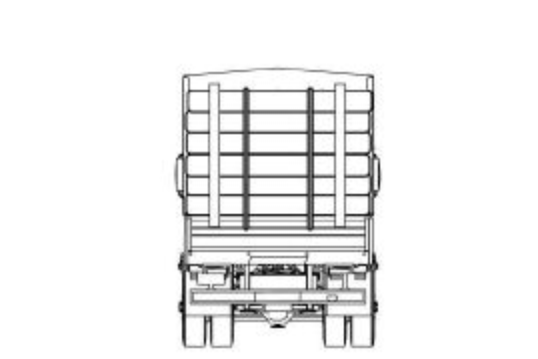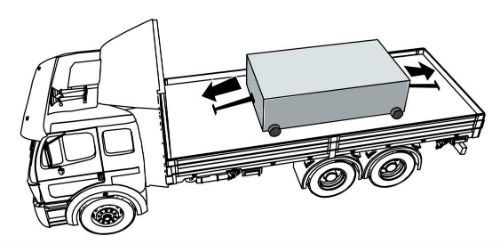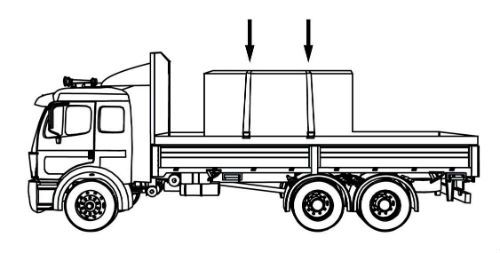CDL Practice Tests: Flatbed Cargo Securement
Choose A Section:
Go!How many knots are acceptable in a properly working tiedown?
- 3
- 1
- 2
- 0
All components of a tiedown must be in proper working order.
- No knots or obvious damage
- No distress
- No weakened parts
- No weakened sections
The North American Cargo Securement Standard cover vehicles weighing:
- 26,001 lbs
- Over 4,500 lbs
- Less than 10,000 lbs
- Over 10,000 lbs
North American Cargo Securement Standard
What does the Standard cover? (Section 1.1)
- Commercial vehicles (including a combination of vehicles) that are operated on a highway and have a gross vehicle rating over 4,500 kg (10,000 lb.)
Vehicles
When securing concrete pipe over 45 inches loaded crosswise, which direction must the tiedowns on the rear half of the load run?
- It doesn't matter.
- Rearward
- Forward
- Straight up and down.
Requirements for securing the pipe
Secure each pipe with tiedowns through the pipe.
Run at least one tiedown through each pipe in the front half of the load. This includes the middle one if there are an odd number. The tiedown must run rearward at an angle not more than 45° with the horizontal when viewed from the side of the vehicle, whenever practicable.
Run at least one tiedown through each pipe in the rear half of the load. The tiedown must run forward at an angle not more than 45° with the horizontal when viewed from the side of the vehicle, whenever practicable. This holds each pipe firmly in contact with adjacent pipe.
To satisfy general cargo securement requirements, what is the minimum WLL for securing vehicles under 10,000 lbs?
- 10,000 lbs.
- 50% of the weight of the cargo.
- 4,500 lbs.
- 30% of the weight of the cargo.
Note: More tiedowns may be required to satisfy the general cargo securement requirements. The Standard states: "The sum of the working load limits from all tiedowns must be at least 50% of the weight of the cargo."
When securing building materials, spacer requirements include all of the following except:
- The height of each spacer must be equal or greater than the width.
- If spacers are comprised of layers of material, the layers must be unitized or fastened together to ensure that the spacer performs as a single piece of material.
- Spacers must provide good interlayer friction.
- The length of spacers must provide support to all pieces in the bottom row of the bundle.
Spacer Requirements
- The length of spacers must provide support to all pieces in the bottom row of the bundle.
- The width of each spacer must be equal or greater than the height.
- Spacers must provide good interlayer friction.
- If spacers are comprised of layers of material, the layers must be unitized or fastened together to ensure that the spacer performs as a single piece of material.
How many tiedowns are required on a stack of shortwood loaded crosswise?
- It depends on the weight
- 2
- 3
- 1
Tiedowns requirements

Use two tiedowns to secure one stack of shortwood loaded crosswise.
Attach the tiedowns to the vehicle frame at the front and rear of the load.
Position tiedowns approximately 1/3 and 2/3 of the length of the logs.
How many anchor points should be used to secure an intermodal container on a chassis vehicle?
- 2 latches in the front and 2 in the middle.
- 2 latches in the middle, and 2 at the rear.
- 2 latches each at or near both the front and rear.
- 4 latches total, anywhere on the trailer.
Secure the front and rear of the container independently.
- 2 latches on the chassis engage anchor points towards or at the front of the container.
- 2 latches on the chassis engage anchor points towards or at the rear of the container.
In cargo securement, what is a 'cleat' defined as?
- A short piece of material, usually wood, nailed to the deck to reinforce blocking.
- Part of the structure, fitting, or attachment on a vehicle or cargo to which a tiedown is attached.
- A tapered or wedge-shaped piece used to secure round articles against rolling.
- A tapered piece of material, thick at one end and thin at the other.
Cleat:
A short piece of material, usually wood, nailed to the deck to reinforce blocking.
When using tiedowns for securing cargo, what is the general rule regarding cargo length.
- 1 tiedown for every 5 ft, or part thereof.
- 2 tiedowns for every 10 ft, or part thereof.
- 1 tiedown for every 15 ft, or part thereof.
- 1 tiedown for every 10 ft, or part thereof.
When cargo is prevented from forward movement (for example, by the headboard, bulkhead, other cargo, or tiedown), secure the cargo according to the following requirements:

All Cargo:
1 tiedown for every 10 ft, or part thereof.
A hook-lift container is:
- A reusable, transportable enclosure that is especially designed with integral locking devices that secure it to a container chassis trailer to facilitate the efficient and bulk shipping and transfer of goods by, or between various modes of transport, such as highway, rail, sea, and air.
- A vehicle especially built and fitted with locking devices for the transport of intermodal containers.
- The load carrying area of a truck, trailer, or intermodal container.
- A specialized container, primarily used to contain and transport materials in the waste, recycling, construction/demolition, and scrap industries, which are used in conjunction with specialized vehicles, in which the container isloaded and unloaded onto a tilt frame body by an articulating hook-arm.
Hook-lift Container:
A specialized container, primarily used to contain and transport materials in the waste, recycling, construction/demolition, and scrap industries, which are used in conjunction with specialized vehicles, in which the container isloaded and unloaded onto a tilt frame body by an articulating hook-arm.
About The Flatbed Cargo Securement CDL Manual
Studying the flatbed cargo securement CDL manual is not a requirement for getting your CDL permit or license. It is required knowledge for flatbed drivers.
Some questions you should be able to answer for flatbed cargo securement:
- What is the minimum Working Load Limit of a tiedown used to secure logs?
- What is the minimum weight of a shipment of paper rolls that would require specific securement requirements?
- When securing concrete pipe over 45 inches loaded crosswise, which direction must the tiedowns on the front half of the load run?
- What is a cab shield?
- When securing concrete pipe over 45 inches loaded crosswise, which direction must the tiedowns on the rear half of the load run?
- What is a dunnage bag?
- Who is responsible for inspecting securing devices and cargo within the first 50 miles?
- How many tiedowns are required on a stack of shortwood loaded crosswise?
- What is the minimum working load limit of each tiedown used to secure crushed or flattened vehicles?
- Define 'bolster'
- What is a hook-lift container?
- When a tiedown is attached directly to the cargo, what is the ideal angle where it attached to the vehicle?
What is a securing device?
Any device specifically manufactured to attach or secure cargo to a vehicle or trailer:
- Synthetic Webbing
- Chain
- Wire rope
- Manila rope
- Synthetic rope
- Steel strapping
- Clamps and latches
- Blocking
- Front-end structure
- Grab hooks
- Binders
- Shackles
- Winches
- Stake pockets
- D-rings
- Webbing ratchet
- Bracing
- Friction mat
What is a tiedown?
A combination of securing devices that forms an assembly that:
- Attaches cargo to, or restrains cargo on a vehicle.
- Is attached to anchor point(s).

Some tiedowns are attached to the cargo and provide direct resistance to restrain the cargo from movement.

Some tie-downs pass over or through the cargo. They create a downward force that increases the effect of friction between the cargo and the deck. This friction restrains the cargo.
 Related Cargo Securement Terms That Every Driver Should Know:
Related Cargo Securement Terms That Every Driver Should Know:
-
Tiedown:
A combination of securing devices which form an assembly that attaches cargo to, or restrains cargo on, a vehicle or trailer, and is attached to anchor point(s).
-
Contained:
Cargo is contained if it fills a sided vehicle, and every article is in contact with or sufficiently close to a wall or other articles so that it cannot shift or tip if those other articles are also unable to shift or tip.
-
Blocking:
A structure, device, or another substantial article placed against or around an article to prevent horizontal movement of the article.
How should tiedowns be attached?
Tiedowns can be used in two ways:
-
Attached to the cargo:
- Tiedowns attached to the vehicle and attached to the cargo.
- Tiedowns attached to the vehicle, pass through or aroundan article of cargo, and then are attached to the vehicle again.
-
Pass over the cargo:
- Tiedowns attached to the vehicle, passed over the cargo, and then attached to the vehicle again.
Tiedown placement:

Place the tiedown as close as possible to the spacer.
Position the tiedowns as symetrically as possible over the length of the article.

Position the tiedowns to preserve the integrity of the article.







 TT On Facebook
TT On Facebook